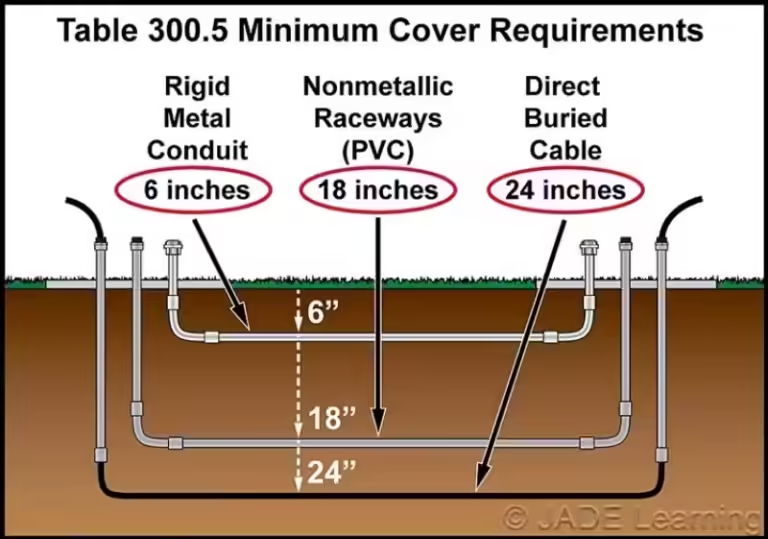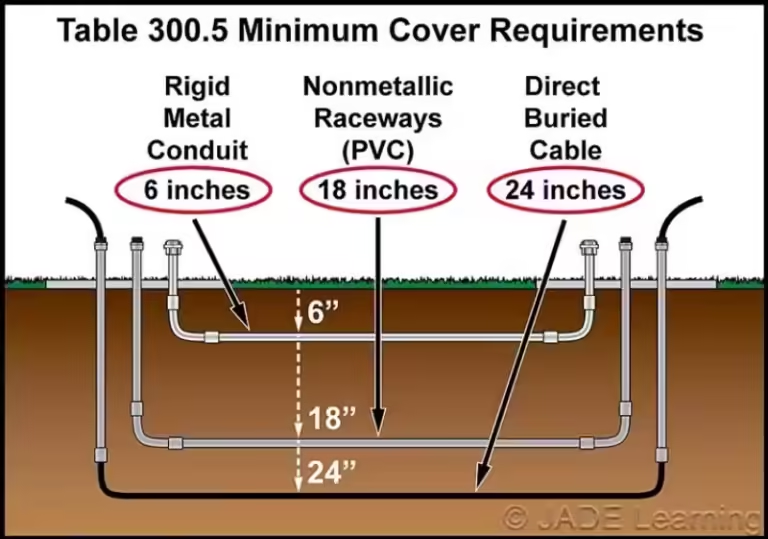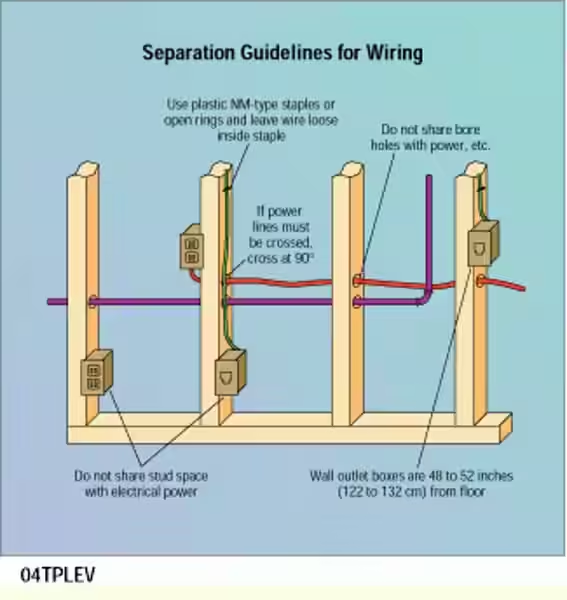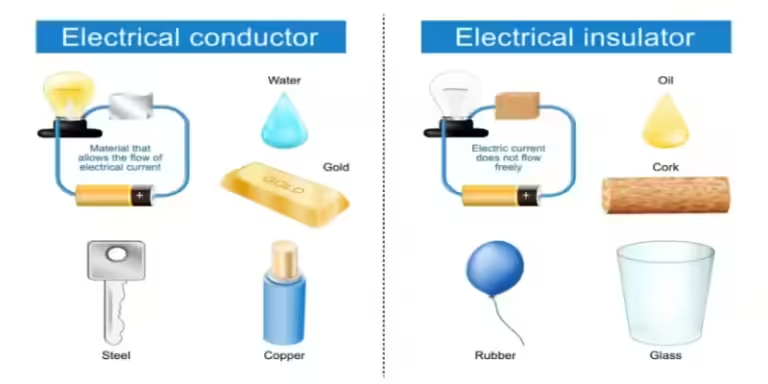How Deep Do Electrical Lines Need to Be Buried? A Comprehensive Guide


When it comes to burying electrical lines, safety and compliance are paramount. The National Electrical Code (NEC), published by the National Fire Protection Association (NFPA), sets the standard for electrical installations, including underground wiring. This guide will delve into the depths of the NEC, exploring specific requirements for various scenarios and providing valuable insights for homeowners and contractors alike.
Understanding the National Electrical Code (NEC): Your Guide to Safe Electrical Installations
The NEC acts as a comprehensive set of rules and guidelines for electrical installations, ensuring safety and preventing potential hazards. It's crucial to consult the latest NEC code and local building codes for specific requirements in your area.
Key Considerations for Outdoor Electrical Wiring
The NEC specifies guidelines for outdoor electrical wiring, encompassing a wide range of factors, including:
Outdoor Receptacles: A Focus on Safety
Outdoor receptacles require special attention to ensure they're weatherproof and safe. The NEC dictates specific requirements depending on the location:
- Damp Locations: Covered porches or areas with potential moisture exposure require weatherproof enclosures with covers opening at least 90 degrees.
- Wet Locations: Uncovered patios or areas exposed to direct rain require extra-duty weatherproof enclosures with 90-degree opening covers.
- GFCIs – Essential Safety Feature: All 125 and 250-volt outdoor receptacles must be protected by Ground-Fault Circuit Interrupters (GFCIs) to prevent electric shock hazards.
- Placement: Single-family homes must have receptacles at both the front and back, no more than 6.5 feet above ground. Multi-family units require at least one receptacle per grade-level unit within 6.5 feet. Deck and balcony receptacles must be placed within 6.5 feet of the surface.
Conduit and Wiring: Protecting Your Electrical System
The NEC outlines specific requirements for conduits and wiring to ensure proper protection and safety:
- Underground Feeders: These must be buried at least 2 feet deep, unless using a conduit. The burial depth for conduits varies depending on the type.
- Direct Bury Cables: These cables must be specifically designed for direct burial and protected with waterproof boxes at connectors and splices.
- Low-Voltage Wires: These cannot be placed in the same conduit as 120/240-volt circuits but can be run in the same trench in separate conduits.
- Backfill: The backfill surrounding the conduit must be free of rocks, sharp objects, and corrosive materials to prevent damage to the conduit or wires.
- Permitted Conduit Types: The NEC allows several conduit types for direct burial, including:
- Intermediate Metal Conduit
- Rigid Metal Conduit
- Liquidtight Flexible Metal Conduit (listed and marked)
- Rigid Polyvinyl Chloride Conduit
- High Density Polyethylene Conduit
- Nonmetallic Underground Conduit with Conductors
- Reinforced Thermosetting Resin Conduit
- Liquidtight Flexible Nonmetallic Conduit (listed and marked)
- Electrical Metallic Tubing
- Type UF Wires (Landscape Lights): These must be buried at least 6 inches underground unless the installation manual specifies otherwise.
- Pool/Spa/Fountain Lighting: Low-voltage (under 30 volts) wires for these systems must also be buried at least 6 inches.
Remember: This is a brief overview. Consult the full NEC code and a certified electrician in your area for precise requirements.
30 Key Points about Electrical Conduit Burial Depth: A Detailed Look
The depth at which you bury electrical conduits is crucial for ensuring safety and preventing damage. This section provides 30 key points to guide your understanding of conduit burial depth requirements.
General Guidelines for Conduit Burial Depth
Here are some general guidelines to keep in mind when determining the appropriate burial depth for electrical conduits:
- PVC Conduit: PVC conduit is commonly used for underground installations due to its resistance to corrosion and moisture.
- NEC Minimum Depths: The NEC sets minimum burial depths for PVC conduit, which vary based on the type of installation.
- Residential: A minimum cover depth of 18 inches is required for residential installations.
- Non-Residential: A minimum cover depth of 24 inches is required for non-residential installations.
- Local Code Variance: The NEC guidelines may not apply in all locations. It's essential to consult local codes and regulations for specific requirements.
- Utility Company Requirements: Additional requirements may be imposed by your local utility company. Verify these requirements before installation.
- Compliance and Safety: Adhering to all applicable codes and regulations is crucial for a safe and compliant installation.
- Vehicular Traffic: Deeper burial may be necessary in areas with heavy vehicular traffic to protect the conduit from damage.
- Verification: Always verify the appropriate burial depth before beginning installation to ensure compliance.
Specifics Based on NEC Guidelines
The NEC provides specific guidelines for conduit burial depth to ensure adequate protection and safety:
- Residential Cover Depth: 18 inches is the minimum cover depth for residential installations.
- Non-Residential Cover Depth: 24 inches is the minimum cover depth for non-residential installations.
- Protection from Damage: These minimum depths are designed to protect the conduit from damage caused by digging, landscaping, or other activities.
- Soil Conditions: Deeper burial may be necessary based on soil conditions, such as loose or unstable soil.
- Detailed Guidelines: The NEC provides detailed guidelines for conduit installation, including specific requirements for various conduit types and locations.
Local Code Requirements: Ensuring Compliance
Local building codes may have different requirements than the NEC. It's crucial to check local codes before beginning any installation:
- Local Code Variations: Local codes may impose stricter requirements or additional specifications than the NEC.
- Compliance with Local Standards: Ensure that your installation meets all local code requirements to avoid fines or penalties.
- Authority Having Jurisdiction (AHJ): Contact the AHJ in your area for clarification on any specific requirements or exemptions.
Utility Company Requirements: Coordinating for Safe Operation
Utility companies may have additional requirements related to conduit installation that must be considered:
- Utility Company Guidelines: Contact your local utility company to inquire about their specific requirements for conduit installation.
- Permits and Inspections: Utility companies may require permits or inspections to ensure the installation doesn't interfere with their infrastructure.
- Safe Operation of Infrastructure: Utility company guidelines help protect their infrastructure and ensure safe and reliable operation.
Vehicular Traffic: Protecting Conduits from Damage
Areas with vehicular traffic require deeper burial to protect the conduit from damage:
- Deeper Burial: Deeper burial is necessary in areas with frequent or heavy vehicular traffic.
- Protection from Vehicle Impact: Deeper burial safeguards the conduit from damage caused by vehicles passing overhead or parking nearby.
- Traffic Type and Frequency: The specific depth required will depend on the type and frequency of traffic in the area.
- Consult Professionals: Consult local codes or engineering professionals for guidance on appropriate burial depth in areas with vehicular traffic.
Prioritizing Safety: Why Burial Depth Matters
Proper burial depth is crucial for the safe and reliable operation of electrical systems:
- Safety of Electrical Systems: Adequate burial depth ensures the safe operation of electrical systems by protecting the conduit from damage.
- Preventing Hazards: Deeper burial helps prevent potential hazards such as exposed wires, electrical shocks, or fires.
- Safety First: Always prioritize safety when installing electrical conduits, adhering to all applicable codes and regulations.
Underground Electrical Installations: A Guide to Burial Depths and Procedures
This section delves into the practical aspects of underground electrical installations, providing a step-by-step guide for residential and commercial projects.
Before You Dig: Essential Planning Steps
Proper planning is essential for a successful and safe underground electrical installation:
- Determine the Optimal Path: Plan the route for your electrical run, considering factors like straight lines, avoiding obstacles, and proximity to existing utilities.
- Call 811: Contact the utility locator service at least two days before digging to prevent damaging underground lines. This service can locate and mark the positions of buried utilities, such as gas, water, electric, and communication lines, to prevent costly repairs and potential injuries.
- Weather and Equipment: Check weather forecasts and reserve necessary rental equipment well in advance to ensure a smooth and efficient installation.
Residential Installations: Following the NEC
Residential underground electrical installations must adhere to NEC guidelines:
- NEC Article 300: This article outlines general requirements for wiring methods and materials, including burial depths for underground installations.
- Table 300.5: This table provides minimum cover requirements for various wiring methods and locations, specifying the distance from finished grade to the top of the buried conductor or conduit.
- Depth Considerations: The minimum depth varies based on the type of wiring (UF cable, direct burial cable, landscape cable), location (front yard, backyard, yard area), and voltage.
- Backfill and Warning Ribbon: After inspection, carefully backfill the trench and use a warning ribbon for service conductors to alert others of the buried line.
Commercial Installations: Adapting to Complex Environments
Commercial installations require similar principles but often involve more complex environments:
- Similar Principles: The same basic principles and codes apply to commercial installations, including the use of Article 300 and Table 300.5.
- Varying Locations: Commercial installations can be more complex, requiring consideration for locations like under buildings, concrete slabs, parking lots, and runways.
- Depth Variations: Burial depths for commercial installations are adjusted based on the location, with deeper burial required in areas like parking lots and shallower depths under slabs.
- Unlisted Locations: For locations not specified in Table 300.5, consult the local Authority Having Jurisdiction (AHJ) for clarification on specific requirements.
Key Takeaways: Ensuring Safe and Compliant Installations
Here are key takeaways to ensure safe and compliant underground electrical installations:
- Thorough Knowledge of the NEC: Industry professionals must be well-versed in the NEC to ensure compliance and avoid costly mistakes.
- Prioritize Safety: Call 811 before digging, plan for proper burial depths, and follow all applicable codes for a safe and compliant installation.
- Continuous Learning: Stay updated on industry standards and best practices through ongoing education and resource utilization.
By following these guidelines and staying informed about the latest NEC provisions, both residential and commercial electricians can ensure safe and compliant underground electrical installations.
Frequently Asked Questions about Burial Depth for Electrical Lines
How deep should electrical lines be buried in residential areas?
The National Electrical Code (NEC) requires a minimum burial depth of 18 inches for residential installations.
What is the minimum burial depth for electrical lines in commercial areas?
Commercial installations require a minimum burial depth of 24 inches according to the NEC.
Are there any exceptions to these minimum burial depths?
Yes, local building codes may have stricter requirements than the NEC. It's crucial to check with your local authorities for specific guidelines.
What about electrical lines for landscape lighting?
Type UF wires used for landscape lighting should be buried at least 6 inches underground unless the installation manual specifies otherwise.
Should I bury electrical lines deeper in areas with vehicular traffic?
Yes, deeper burial is recommended in areas with vehicular traffic to protect the lines from damage. Consult local codes or engineering professionals for specific guidance.
What type of backfill should I use after burying electrical lines?
Use a backfill that is free of rocks, sharp objects, and corrosive materials to avoid damaging the conduits or wires.
Is it okay to bury low-voltage wires in the same conduit as 120/240-volt circuits?
No, low-voltage wires cannot be in the same conduit as 120/240-volt circuits, but they can be in the same trench in separate conduits.
What types of conduits are permitted for direct burial?
Permitted conduit types for direct bury include: Intermediate Metal Conduit, Rigid Metal Conduit, Liquidtight Flexible Metal Conduit (listed and marked), Rigid Polyvinyl Chloride Conduit, High Density Polyethylene Conduit, Nonmetallic Underground Conduit with Conductors, Reinforced Thermosetting Resin Conduit, Liquidtight Flexible Nonmetallic Conduit (listed and marked), and Electrical Metallic Tubing.








